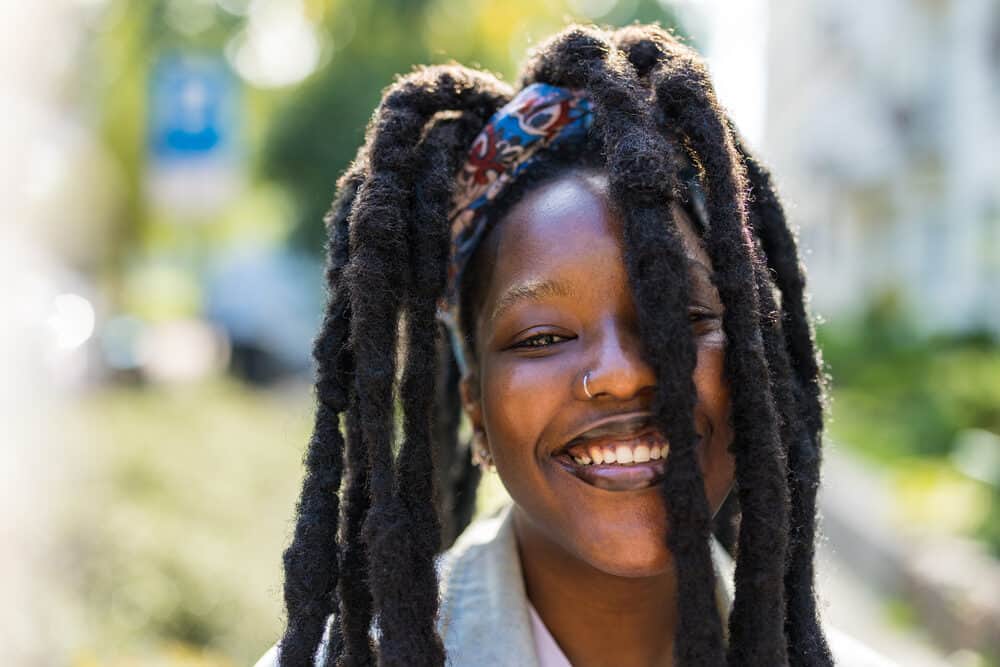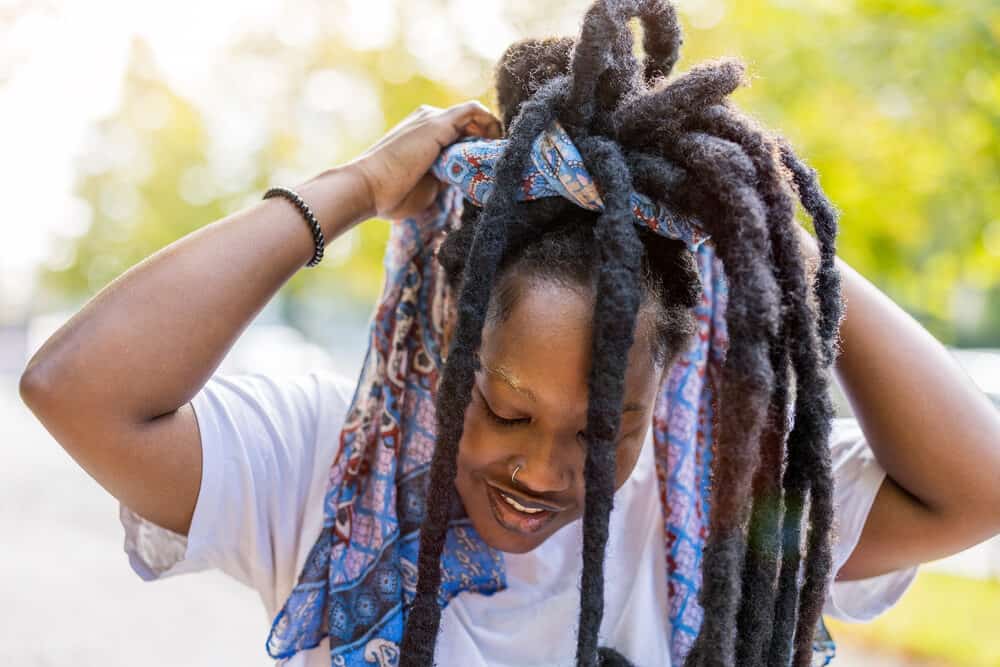
Wicks have exploded in the loc community as of late. There’s a good chance you've seen celebrities and social media influencers wearing the iconic style.
If you want to learn about the origin of wick dreads and find out how you can jump on the bandwagon, you’re in the right place. In this article, we’ll share everything you need to know about wicks, one of the coolest dreadlock styles today. Let’s get right into it!
Table of Contents
What Are Wick Dreads?
Wick dreads are some of the thickest dreads you can get. They are so thick, in fact, that some have as few as 4-10 wicks on their heads. The hairstyle takes its name from the everyday candle wick, which stands straight up, though long wicks hang downward.

Where Did Wick Dreads Originate?
Wicks originated in South Florida, but they truly became mainstream when celebrities such as Kodak Black were seen sporting them. Shortly after, people begin to imitate the style.
It's not surprising that wicks have found their way into mainstream loc culture, given how much influence celebrities have on the public.
Wicks vs. Congos
It’s easy to get confused between wicks and congos, but it’s important not to get them mixed up.
Congos refer to when two or more dreadlocks merge into one at the roots. They may be any size. They don’t usually fuse completely and have ends that stick out like tiny fingers. Wicks, on the other hand, are super thick locs that have smooth, rounded ends.

How Long Does Your Hair Have to Be to Get Wicks?
If you’re wondering if you have enough hair for wicks, this section is for you. You’ll need at least 6 inches of hair to start your wicks. That’s enough hair to stand a few inches higher than your scalp after forming the wicks.
Starting with enough hair makes the wick cultivation process easy and keeps your wick installation costs low.
This is not to say that you can’t install wicks on long hair. The main benefit of starting wicks with long hair is that you get to have long wicks right off the bat. Unfortunately, some struggle to get through the process of crocheting long sections of hair or long locs. It can take hours upon hours.
How to Start Wick Locs
There are four main methods of starting wicks, and we’ll give you a rundown of all of them in this section.

The Crochet Wick Combine Method
The crochet wick method is the most popular way of creating wicks. It requires you to combine the locs with a crochet needle. You won’t have to wait for your wicks to form over time - you get them instantly.
Here are the steps to follow to turn your loose hair or traditional locs into wicks.
- Start by sectioning your locks or loose hair using rubber bands to get an idea of how many wicks you want. Some people prefer a few wicks, and others prefer more. Put the rubber bands only at the roots of each section.
- Cultivate your wicks. You’ll use single, double, or triple-prong crochet needles to create your wicks' internal structure and external shape. While holding your hair in between your thumb, index, and middle fingers, begin crocheting. Start near the roots of the hair or locs and pull the crochet tool in and out of the section repeatedly. Crochet all around the loc to create a rounded shape. You’ll notice the hair starting to fuse and tangle in a cylindrical shape. Gradually move down the section of hair to form the entire wick.
Watch this video to see a demo on how to combine traditional locs to make wicks.
Watch this video to see how to crochet wicks on loose natural hair.
Crochet Wick Extensions
If you want long wicks now, consider crochet wick extensions. They can be used to start your wick journey or lengthen your existing wicks. To start wicks with extensions, follow the below instructions:
- Choose your wick extensions. Wick extensions come in various sizes and lengths. You can go for small, medium, large, or jumbo wicks, depending on your desired look.
- Oil your scalp thoroughly with an oil of your choice.
- Section your hair and put a rubber band at the roots of each section. It’s important to make the sections the right size for the extensions you bought. If you don’t, your new growth will not match your wick extensions. Your parts should be considerably larger than your wick extensions. If you’re not sure how large to make your parts, consult a loctician.
- Take one of your wick extensions and use the end of a rat tail comb to undo a couple of inches of it (if needed). Some come with one end loose for attachment, while others don’t. You need some loose hair to crochet and connect to your natural hair.
- Sandwich your natural hair in the loose end of the wick extensions and begin to join the two with a crochet needle. Fuse them together by moving the needle in and out where the wick extensions and the natural hair meet. Crochet all around the section to create roundness.
- Repeat the previous two steps for the rest of the sections.
The Freeform Method

It’s also possible to grow wicks freeform, and here’s how to do it. You start by allowing your hair to grow and lock freely (i.e., naturally lock) without manipulating it much. Just wash and oil your hair as needed.
Whenever your roots begin to fuse into one loc, separate them according to the thickness and number of wicks you want. Over time, this will result in natural wicks.
Keep in mind that freeform wicks will not have as clean an appearance as crocheted wicks. If you want your wicks to be perfectly cylindrical, go for crochet wicks.
Rubberband Method
The rubber band method is a great way to get wicks on loose afro hair. All you have to do is group your loose hair into large sections and put rubber bands down the length of each section.
Leave the rubber bands in for 3 weeks to a month the first time around. After that time, take the rubber bands off and check if your hair is starting to lock on its own.
If it isn’t locked, put the rubberbands back on and wait for 3 to 4 more weeks. Once your hair is locked, you won’t need the rubber bands anymore.
Wick Care Tips
As you’re cultivating your new wicks, keep the following tips in mind:
- Make sure all your wicks are the same size for a nice, uniform look.
- Don’t neglect your wicks. Wash them regularly using a clarifying shampoo. To maintain hygienic wicks, wash your hair once or twice a month, depending on how quickly they get dirty.
- Moisturize your scalp frequently, and don't forget to cover your hair up at night with a silk or satin bonnet or scarf.
- After washing the wicks, dry them with a microfiber towel and then air dry or blow dry them thoroughly. Doing so will prevent mold and mildew growth.
- Spray some rose water and a lightweight oil on your wicks daily to keep them hydrated.
How Much Does It Cost to Wick Dreads?
Starting wick-dreads will cost you between $100-$300 depending on your hair length and the salon you choose. The cost of dreadlock maintenance, including re-twisting or re-wicking, can also vary, but on average, it's between $50 to $250+ per appointment. It's best to consult with a local stylist for a more accurate estimate.
How Long Does It Take for Wick Dreads to Lock?
The time it takes for dreadlocks to fully form and lock depends on your hair type and texture, the method used, and your desired outcome. It can take several months to years. To begin, it's recommended to leave rubber bands in for 3-4 weeks. If the hair still isn't locking, keep them in for an additional 3-4 weeks.
Can You Undo Wick Dreads?
Undoing wick dreads is a time-consuming and potentially damaging process, but it's possible. The removal process typically involves gently combing or cutting them out, which can take several hours, depending on the length and thickness of the dreads. After removal, the hair may need to be trimmed and conditioned to repair any damage that occurred during the dreadlocking process.
Who Started Wick Dreads?
While the exact origin is not completely clear, it is believed that the style of Wick dreads was created and popularized in the South Florida area in the late 20th and early 21st centuries. The name "Wick" is thought to have been derived from the word "wicky," used to describe the sleek and tight appearance of the dreadlocks.
- Dreadlock Size Chart
- Learn How To Do Dreads
- Is Interlocking Better Than Palm Rolling?
- Dread Detox Recipe
Now you know what wicks are, what they’re not, and how to create them on locs and loose hair. With the right method, you’ll have proper wicks within weeks. We hope this article was helpful to you and wish you the best on your wick journey!




